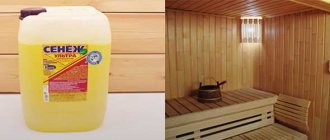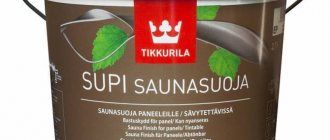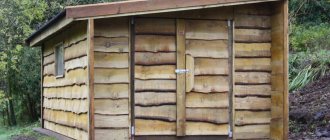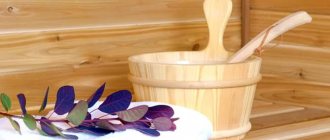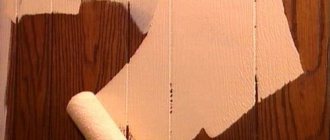Lining is one of the most popular materials for finishing baths and saunas. Natural wooden slats fit organically into the interior, maintaining environmental friendliness and a unique cozy atmosphere of the room. They look aesthetically pleasing and attractive, are easy to install and last a long time. In addition, wooden materials promote good air exchange, fill the room with a pleasant forest aroma and have healing properties.
But over time, the lining without proper care begins to darken and loses its attractive appearance. This occurs due to regular exposure to humidity, water and temperature changes. In addition, when using brooms, especially oak brooms, drops and splashes, which include tannins, fall on wooden surfaces. These elements cause natural wood to darken and turn black.
Soot and soot are integral elements when heating and using a bathhouse or sauna. They settle and gradually accumulate on the walls, floor and ceiling, on bath furniture and window sills. As a result, the materials lose their presentable appearance. Among other things, wood absorbs various fats and dirt, which causes dark spots on surfaces. In this article we will look at how to clean the lining in a bathhouse from soot, blackening and dirt.
Basic Rules
How to clean soot in a bath? There are certain rules for this. For example, wooden surfaces covered with a layer of soot should not be wetted.
Wood is a hygroscopic material that quickly absorbs moisture. Together with water, everything that has settled on the surface - soot, soot, bodily fluids, etc. - will be absorbed into the structure of wooden elements. Once the dirt is absorbed into the surface of the wood, it will be almost impossible to clean the shelves in the bathhouse, walls, floor or ceiling.
Therefore, when deciding how to clean soot from walls or floors in a bathhouse, you should categorically refuse to use such substances and materials as:
- laundry soap;
- water;
- sponges;
- spray guns.
All of the above products can only be used for final cleaning of wooden surfaces, when the carbon deposits have already been cleaned dry.
All work on cleaning the bathhouse from soot and soot must be carried out using special protective equipment:
- blind safety glasses;
- respirator;
- thick rubber gloves.
All this will help prevent combustion products from entering the respiratory tract.
How to wash shelves?
The shelves and benches in the steam room become dirty from aromatic oils, hot water and sweat, since wood absorbs liquids well. Hard-to-remove stains form on surfaces. Sometimes you can get rid of them only by cleaning the cycles. This damages the outer layer of the wood. Therefore, it is recommended to cover shelves with special protective compounds. Under no circumstances should you use varnish that, when heated, can cause burns.
A car wash is often used to clean shelves. Karcher supplies water mixed with air under pressure. This easily removes dirt from surfaces.
To whiten bath shelves that have become blackened over time, you can use an antiseptic bleach designed for baths and saunas. If you are against “chemistry,” ordinary river sand, which you carefully rub on the surface, will help.
Cleaning walls and ceilings
Solving the problem of how to clean soot in a bathhouse begins with a vacuum cleaner. To do this, you need to walk it on wooden surfaces. Next, you need to carefully sweep away the soot and soot from the walls and ceiling with a broom.
Prepared surfaces must be cleaned with specially impregnated sponges. They are sold in hardware stores. During the manufacturing process, such sponges are impregnated with special compounds that destroy soot and soot.
Sponges get dirty quickly, so you need to purchase several of them at once. You can extend the life of use by cutting off the soiled layer of the sponge. When the soot and soot have been completely removed, you can clean the surfaces of the walls, floors and ceilings with aqueous solutions of detergents.
Abrasive powders cannot be used in this case. They spoil the structure of wooden surfaces.
On a note! It is advisable to use degreasing powders and/or gels. They are added to hot water.
To clean hard-to-reach areas, it is better to use a mop with a long handle.
Surfaces are washed 2-3 times. In this case, the water must be changed periodically, adding a new portion of detergent to it.
When the question of how to clean the lining in a bathhouse from soot has been resolved, you need to rinse off the cleaning solution with clean water. For this it is better to use running water. It is better to feed it from a hose under low pressure.
At the end of the process, wipe the washed surfaces dry with a clean soft cloth. You can use an old bath towel. A large amount of moisture or poor thermal insulation may cause the lining to turn black. In this case, the answer to the question of how to clean the lining in a bathhouse will be a grinding machine, but this is if the darkening has affected only the surface layer of wood.
To clean walls lined with clapboard, you will need an angle grinder with a power of no more than 1 kW and a flap wheel with a diameter of 125 mm (grit size no more than 40 units). The lining is sanded in such a way as to remove the darkened layer to a depth of approximately 3 mm.
If the blackness has been absorbed to a great depth, the lining can be painted. But not in the steam room. No paint coatings are used here at all. You can replace the darkened lining partially or completely with new material.
Impregnating compositions for bleaching darkened wood, prepared on the basis of chlorine, are not recommended, since the carbon particles that determine the dark color of the walls are practically not discolored by compositions containing active chlorine.
Over time, unaesthetic dark spots appear on the surface of the bathhouse logs on the outside, which spoil the appearance of the structure.
Liquid bleach can be used to remove such stains. It is applied to a surface that has been previously cleaned of dust and dirt. For work, brushes with artificial bristles are used, which need to be changed periodically, because the cleaning composition corrodes them. Before applying, you need to test its effect in an inconspicuous place.
The product is carefully distributed over the entire surface and left for some time according to the instructions on the package. Then you need to rinse the surface with running water from a hose. Next, the bathhouse is ventilated to remove the pungent odor of bleaching agents.
If the blackening penetrates to a greater depth, the logs can be sanded with a grinder. In this case, safety precautions must be observed.
To clean the shelves in the bathhouse, you can use a car wash. Water is supplied through it mixed with air and under high pressure. This helps to easily remove the top layer from darkened wood. In this way you can also clean the floors, walls and even the ceiling in the bathhouse.
To thoroughly clean the floor in the bathhouse, you can use a plane, preferably with an electric drive. First, the floorboards must be carefully removed and thoroughly dried, then processed with a plane. In this case, the top layer of wood on each side is removed to a depth of 5 to 10 mm.
This type of cleaning often results in sharp edges on the floorboards. They can be removed with a belt or vibratory sander. You can also use these devices to clean up darkened wood instead of using a plane.
If the darkened layer of wood is thin, you can simply sand the surfaces with sandpaper. An electric drill with a special attachment will help make the process easier. You can only work with completely dry surfaces.
This method will help you get into corners and other hard-to-reach places. There is no need to remove individual elements.
This treatment is often recommended when answering the question of how to clean aspen seats and other wooden surfaces in a bathhouse. After processing and sanding with sandpaper, they will not only be clean, but also absolutely smooth.
What to use?
Lining is a “breathing” building material, so it regularly absorbs dust, dirt, soot, and other types of contaminants from the air.
Coating its surface helps reduce damage to wood:
- impregnations;
- wax;
- paints (how to paint lining correctly?);
- varnish (how to varnish the lining?).
But even they will not completely protect the finishing board from stains appearing on it. What can and cannot be used to clean the lining?
Recommended means of removing contaminants from finishing materials include:
- soap solutions;
- scrapers with sharp bases;
- brushes for cleaning wood;
- grinding machines.
Before sanding the lining, you need to carry out a test stripping on a separate piece of material or on the least noticeable area of the surface being treated. Otherwise, instead of a clean slate, you may end up with completely damaged material.
What should not be used?
Do not clean the finishing board with:
- Hard metal brushes and sponges. Their aggressive impact will lead to an increase in wood porosity and even deeper penetration of contamination.
- Household chemicals (washing powder, dishwashing detergent, liquid soap). Such detergent compositions are not intended to work with lining, so the result of their impact on it is difficult to predict.
- Acidic, alkaline or chlorinated compounds for household use. For example, Belizna or Domestos are very helpful during cleaning, but they are completely unsuitable for disinfecting finishing building materials.
Firstly, all aggressive cleaning products have a strong, unpleasant odor that is absorbed into the wood literally forever. And, secondly, they reduce the protective functions of paints and varnishes, significantly reducing the service life of the lining.
Why does the chimney become dirty?
How to clean a chimney in a bathhouse depends on the nature of the contamination. With use, types of clogging may occur such as:
- soot and soot, which accumulates very quickly when burning household waste;
- condensation that forms due to irregular use of the bathhouse;
- foreign objects accidentally falling into the chimney.
All of these types of contaminants ultimately impede the free circulation of air and the escape of smoke through the chimney.
This may cause carbon monoxide poisoning. Condensate is a weakly concentrated acid solution. Under its influence, the chimney masonry begins to collapse from resinous deposits. If you use a sauna regularly, you need to make a schedule and determine in advance when and how to clean the pipe in the sauna. Carrying out such work regularly will preserve the chimney and stove and allow you to use the sauna without any problems.
Available methods for processing lining
As a rule, the lining in the steam room is left unchanged, but in the waiting room and washing department it is treated with protective agents. Without additional processing, the material quickly loses its attractiveness and performance characteristics, and therefore requires replacement every 3–5 years.
If you need to protect a decorative board in a steam room, then you should know what special products are intended for use in rooms with high levels of humidity.
Processing of the lining inside the bathhouse is carried out:
- varnishes;
- impregnations;
- oils;
- antiseptics;
- flame retardants.
For the steam room, it is recommended to use safe natural products that create a protective wear-resistant layer on wooden surfaces. Such preparations include special fungicides and insecticides that can prevent the development of fungi, mold and pathogens.
How to clean a chimney
The chimney and pipe in the bathhouse are cleaned chemically and/or mechanically. In a special store you can purchase liquids and/or powders for cleaning the chimney. Detailed instructions are printed on the packaging. After reading it, it will become clear how to clean a pipe in a bathhouse.
A good answer to the question of how to clean soot in a bathhouse that has accumulated in a chimney would be a “log chimney sweep.” It is impregnated with special chemicals. During combustion in the furnace, smoke of a special composition is released. As a result, the soot becomes soft and pliable. After 2 or 3 days it can be removed with brushes without much difficulty.
For mechanical cleaning of the chimney you will need the following tools and devices:
- rope and/or rope;
- weight (ball);
- brush-ruff (preferably on a thin metal cable).
First you need to check the safety of the structure. Then you need to remove any objects that accidentally got into them from the pipe and chimney. For this purpose, a brush-ruff is used, selected according to the size and shape of the pipe.
A special modern brush will make cleaning work easier. It comes with a handle consisting of several links. This allows you to adjust the length of the brush as needed. During cleaning work, any brush must be moved inside the pipe, gradually moving it lower and lower.
Such work must be performed in a special set of clothing, which must include:
- overalls or suit;
- respirator;
- gloves;
- protective glasses.
If the chimney is not very dirty, you can call a specialist. He will clean it using a special high-power vacuum cleaner. This will remove soot from the chimney through the firebox opening. The use of special means will help resolve the issue of how to clean the chimney of contaminants and how to clean the pipe of soot in a bathhouse.
Special chemicals for soot removal
There are special chemical liquids designed to completely neutralize soot and unpleasant odors after fires. They are not sold in every store, but it is quite possible to get them in specialized retail outlets. They perfectly remove soot even from porous surfaces such as concrete and brick.
The most popular effective professional soot neutralizers:
- Facade cleaner No. 2.
- Mazbit+.
- Clean-Dezo.
- BZ-20.
The products are available in the form of colorless liquids poured into plastic canisters.
These were the most effective recommendations on how and how to wash off soot on your own. If there is extensive soot after a fire, it is better to call a special service for your own safety. A burnt-out room has a high concentration of toxins and it is necessary to work in it in a special protective suit.
Cleaning the tank
Due to the hardness of tap water, the question periodically arises of how to clean the tank in a bathhouse from scale that settles on the walls and bottom. Since scale is formed from lime deposits, it must be cleaned with acid.
Acid can only be used of organic origin. For example, lemon or vinegar. Any inorganic acid is unsafe for the metal from which the tank is made. It should be remembered that the amount of acid used to clean the tank should approximately correspond in weight to the amount of lime deposits on the walls of the heating tank.
On a note! Installing a special filter at the inlet will help prevent the formation of large amounts of scale.
The water passing through it will be purified from a significant amount of impurities. This will greatly reduce the level of scale formation.
Lightening wood with oxalic acid
Oxalic acid should be used with caution as it is very poisonous. Before applying the acid, the surface is treated with sodium hydrosulfite, and then almost immediately the wood is coated with a 10% solution of oxalic acid. After five minutes, both compositions are washed off with water.
Oxalic acid is well suited for bleaching light wood: maple, poplar, birch, linden. To achieve the desired effect, 6 ml of oxalic acid is diluted with 0.1 liter of water. The acid remaining on the wood is neutralized with the following composition: 15 g of bleach, 3 g of soda ash and 0.1 l of water. Then the wooden surface is washed with water.
Cleanliness in the steam room
The steam room in the bathhouse requires special attention. After all, when using brooms, particles of plant pigment from stems and/or leaves are absorbed into wooden shelves and walls along with moisture. Therefore, the question inevitably arises of how to clean the steam room in a bathhouse to give it a fresh and pleasant look.
The problem of how to clean linden lining in a bathhouse, especially in the steam room, can be solved in different ways. If the wood darkens slightly, you can use special liquid detergents and/or paraffin oil.
The cleaning liquid is applied to the darkened surfaces manually using a piece of foam rubber or a regular sponge. The pre-detergent must be diluted with water. How to do this is detailed in the instructions.
Paraffin oil is gradually applied to pre-dried surfaces using a dry sponge. In this way, you can not only clean the lining in the steam room, but also give the wood water-repellent properties. This will protect the wood trim and various items from severe and rapid contamination.
General recommendations
When using any chemical, you must follow basic safety rules - protect your respiratory system with a respirator, and the skin of your hands with clothing, long sleeves and thick gloves. Otherwise, there is a risk of irritation or burns. It is recommended to further protect the mucous membrane of the eyes by wearing glasses.
When treating the ceiling or upper parts of walls, it is worth protecting your hair and scalp by wearing a hat. Before using a finished chemical, be sure to study the instructions and treat only those surfaces for which they are intended.
Bath water purification
The required amount of water for hygiene procedures is often provided by drawing water from a nearby reservoir, well or borehole. Before use, it is necessary to thoroughly clean the bath water from various impurities, silt, sand, and small pebbles.
The main methods of water purification are filtration and sedimentation. You can buy a special water filter in a store or make it yourself. For this you can use a fine mesh.
To settle, water is poured into a large tank about a day before its intended use. During this time, all impurities will gradually settle to the bottom of the tank. From above it will be possible to take clean water suitable for hygiene procedures.
The basic rule: the settled water should be taken from above, trying not to raise sediment. The water is not used until the end. It is better to pour the remains into the drainage well along with the sediment. Therefore, you need to prepare water with a reserve.
Industrial bleaches
Domestic and foreign industry today produces many effective and affordable products that can be used to whiten a log or timber house.
According to experts, one of the best bleaches is the Russian drug “Sagus”, which is used to prevent the formation of corrosion, and also effectively treats wood from fungus and whitens the surface.
Sagus not only lightens the wood, wood bleached with the product acquires an even shade, and black spots and spots disappear from it. The composition is resistant to weather conditions and humidity, so it can be used both inside and outside the house.
Another domestic product that is used to bleach wood is Neomid 500. It rids wood of fungus and mold, evens out the color, and also protects it from insects. For deep lesions, a concentrated composition is used. If there are only small pockets of fungus on the tree, the composition is diluted with water in a 1:1 ratio.
Proper maintenance of the bath
To prevent severe contamination and the appearance of fungus, mold, and woodworms, the bathhouse must be kept clean at all times. It is advisable to periodically treat internal surfaces with antiseptics to protect against microorganisms.
To prevent rotting of wooden coverings, it is necessary to apply special compounds to walls, shelves, etc. All wooden surfaces should be inspected periodically. Elements affected by rotting must be removed partially or completely.
After each use, the bathhouse must be ventilated to dry the interior. Immediately after taking bath procedures, you need to do cleaning. This will remove any stains from the interior surfaces before they are absorbed into the wood.
On a note! An important point is to remove leaves and small particles of used broom from wooden surfaces.
They are removed with a special brush, sponge or rag. After that, shelves and other surfaces should be washed with warm water. This will help remove residual sweat, detergents, etc.
The remaining water on the floor must be carefully adjusted to the drain holes. When cleaning, special attention should be paid to the space under the shelves.
To prevent cockroaches or mice from getting in, all leftover food from the rest room must be removed immediately and the trash taken out. Bath accessories should be dried and placed in storage areas. The final stage is wet cleaning of all sections of the bathhouse. It is also necessary to carry out general cleaning periodically. Proper maintenance of the bathhouse will preserve the attractive appearance and cleanliness of the interior space, as well as the integrity of all coatings.
Causes of fungus formation
Fungus and mold can develop on any wooden surface, regardless of lumber; even imitation timber and laminated veneer lumber are not immune to damage by microorganisms.
The type of wood also does not matter in this case; fungus can appear on both inexpensive pine and elite oak. A very common reason for the appearance of blue stains is improper transportation and violation of storage conditions of logs and timber. Lumber should be stored in a well-ventilated, dry place. It is advisable that the area is in the shade and that the tree is not exposed to precipitation.
Fungi that contribute to the formation of blue and gray plaque on wood develop very quickly, especially in suitable conditions. Therefore, you need to get rid of mold and mildew as soon as traces of their presence are discovered, especially in the bathhouse. This room creates the most favorable conditions for the proliferation of microorganisms - high temperature and high humidity, which significantly speed up the process.
In the bathhouse there are ideal conditions for the formation of fungus; heat and moisture contribute to the rapid destruction of wooden lining. Therefore, the panels should be protected with special compounds. In addition to the fact that they allow you to whiten the surface, they also prevent the formation of fungus and mold:
- Snegurochka-2 - this composition completely disinfects and bleaches even wood that has darkened over time.
- Supi Saunapesu is a Finnish-made product created for disinfecting and bleaching lining in a steam room.
After processing wooden lining, you need to carefully monitor and care for the surface. After each use, it is necessary to thoroughly ventilate and dry the room and clean it. In winter, you should cool the bathhouse with frosty air.
If you do everything correctly and carefully monitor the premises, then the next major renovation in the bathhouse will not be soon.
Peculiarities of processing lining in the washing compartment and dressing room
Decorative finishes in the wash compartment are constantly exposed to the negative effects of steam and water. Therefore, providing protection with antiseptic compounds is a top priority.
You can cover the lining in the bath with the following preparations (our recommendations):
- “Senezh Sauna” is an antiseptic impregnation to protect wood from damage by fungi, mold and wood-boring insects. It is intended for treating wall and ceiling surfaces, as well as doorways in rooms with high humidity and temperature changes.
- Dulux Celco Sauna is a water-based varnish with good moisture and heat-resistant characteristics. Allowed for use in rooms with a temperature range from 70 to 120 degrees. The varnish is resistant to darkening, has no unpleasant odor, and dries quickly.
- “Snegurochka 2” is a two-component antiseptic composition that prevents the formation of mold and mildew, ensures the sanitation of wood, and helps lighten lining that has darkened due to prolonged contact with water.
To paint the lining and prevent the negative effects of moisture, steam and temperatures, it is necessary to use safe protective compounds for wood. Even a novice craftsman with minimal experience working with painting tools can master the technology of processing wooden surfaces in a bathhouse.
Buy a detergent
MAZBIT PLUS - Concentrated product designed to clean surfaces from the effects of fire.
Designed for effective quick cleaning of any surfaces: general construction materials: wood, concrete, plaster, stone, tiles from various contaminations by combustion products: soot, soot, carbon deposits.
More details
However, during operation, a wooden bathhouse can cause some difficulties, one of which is soot deposition.
In addition to the fact that it looks very unaesthetic and dirty, such deposits can also be harmful to health, since in large accumulations they tend to release carcinogenic substances.
Therefore, at the first sign of them, you should take care of how to wash soot from a tree in a bathhouse.
You can buy a product for cleaning bath soot from walls in a specialized store of our company.
The concentrated water-based product has an enhanced effect on soot, an environmentally friendly composition, and high resistance to temperature changes.
On the company’s website you can view the product catalog and order any batch of detergent for cleaning soot from the manufacturer at affordable prices.


